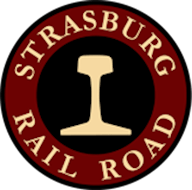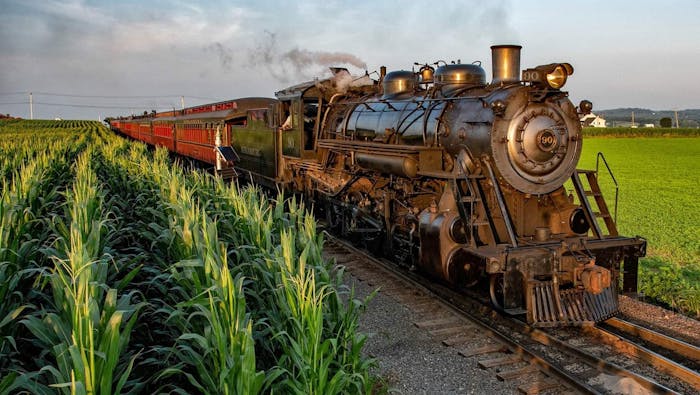If you follow lots×10¹⁰⁰ of <strike>rules</strike> Trains!
-
And if you want to move freight for real, you use a boat.
Right, because a network of canals across our 3000-mile-wide country would be an even better idea than a continent-wide HSR passenger network.
-
provided the rail network is configured to allow things to run smoothly.
[didn't get your mouseover text] So are you suggesting taking freight off the existing network or building a whole new one? [INB4 the last sentence of your post, that I didn't bother quoting.]
Also, not really replying to you per se, but how well does HSR do in big mountain ranges, like the several we have in the left half of our country?
-
Also, not really replying to you per se, but how well does HSR do in big mountain ranges, like the several we have in the left half of our country?
Usually they cope by going through tunnels
-
Usually they cope by going through tunnels
I cordially invite you to look at a map of the western US and consider the length of tunnel(s) that would be required.
ETA: There are a host (or maybe less) of subissues I'm deliberately ignoring, including the fact that I know some of the bigger Euro tunnels have air stacks, because I don't know enough about the topic to discuss whether they're relevant or not.
-
Japan managed it :P
-
Usually they cope by going through tunnels
Why would you want to make tunnels through mountains when you could just fly over them? That's boring.
-
Right, because a network of canals across our 3000-mile-wide country would be an even better idea than a continent-wide HSR passenger network.
Actually, you try to move freight along existing waterways (like the ocean, the great lakes, or major rivers), only building new ones where necessary. And in fact that will be already happening. It doesn't work so well for a lot of the western US though; not the right sort of topography and not enough rain. (The overall point was actually about why a smaller proportion of freight in Europe moves by train: we've got more convenient water transport available. It's happenstance.)
So are you suggesting taking freight off the existing network or building a whole new one?
I'm saying that it is impossible to run a lot of passenger traffic with the amount of freight traffic you've got given the current rail configuration. I'm leaving open what is done about it.
how well does HSR do in big mountain ranges
Like any train system in mountainous terrain, you're talking tunnels (especially under key passes), bridges (because mountains have deep valleys), running along the side of ridges, that sort of thing. It therefore should do reasonably, particularly as there's not usually a lot of need for building major stations in the middle of mountains.
 It's purely an engineering problem, ensuring that the design criteria for supporting HSR are met by the detailed route taken.
It's purely an engineering problem, ensuring that the design criteria for supporting HSR are met by the detailed route taken.The key to keeping the cost down seems to be to find a valley that goes in about the right direction and to follow that. We'd have to actually start looking at specific cases to say much more than that. (Specific cases: most of the route between Seattle and Portland would be following valleys, as will most of the route between LA and SF.)
The longest tunnels tend to either be sub-sea or in urban areas. The former because long sea bridges have their own challenges (e.g., wind speeds are much higher at sea than over the land) and the latter because land prices are much higher there. And tunnels tend to be more acceptable politically too; politicians find telling lots of constituents that their homes are going to be pulled down to make way for a railway a rather harder sell than normal. ;)
-



-
-
Argh! Wikipedia-sniped! There went the morning…
-
I cordially invite you to look at a map of the western US and consider the length of tunnel(s) that would be required.
HSR is actually more tolerant of grades than heavy freight rail is. (Passenger trains are vastly overpowered compared to their freight counterparts, and HSR also gives you more momentum to "roller coaster" over hills with.)
There are a host (or maybe less) of subissues I'm deliberately ignoring, including the fact that I know some of the bigger Euro tunnels have air stacks, because I don't know enough about the topic to discuss whether they're relevant or not.
The Moffat Tunnel has a fairly sophisticated ventilation system as well...Actually, you try to move freight along existing waterways (like the ocean, the great lakes, or major rivers), only building new ones where necessary. And in fact that will be already happening. It doesn't work so well for a lot of the western US though; not the right sort of topography and not enough rain. (The overall point was actually about why a smaller proportion of freight in Europe moves by train: we've got more convenient water transport available. It's happenstance.)
Yeah, the Continental Divide gets in the way of that...I'm saying that it is impossible to run a lot of passenger traffic with the amount of freight traffic you've got given the current rail configuration. I'm leaving open what is done about it.
We are beefing up the rail network already...The key to keeping the cost down seems to be to find a valley that goes in about the right direction and to follow that. We'd have to actually start looking at specific cases to say much more than that. (Specific cases: most of the route between Seattle and Portland would be following valleys, as will most of the route between LA and SF.)
Agreed, but much of the problem with greenfield rail routing isn't finding suitable routes, it is buying the land
-
Agreed, but much of the problem with greenfield rail routing isn't finding suitable routes, it is buying the land
It's worse in Europe, I can assure you. Land in (the vast majority of) the US is crazy cheap by comparison.
-
It doesn't work so well for a lot of the western US though; not the right sort of topography and not enough rain.
Hey, that might even have been my point!
We'd have to actually start looking at specific cases to say much more than that.
Specific-case-wise, your examples aren't much of a problem, probably, but we probably need at least 2-3 east-west routes, and the western US has some pretty large ranges. Might need a lot of tunnels and bridges. Might be too expensive to be worth it.
-
that title was annoyingly long. i shortened and lengthened it at the same time.
-
Gotthard Base Tunnel
is the one I was thinking of but wasn't going to bother to look up. I wonder if anyone's done any even half-assed estimates of how much more you'd have to do in the US.
-
HSR is actually more tolerant of grades than heavy freight rail is.
I'd also imagine that the HSR routes will mostly run fairly close to existing rail lines; it's not like the old railway engineers didn't know what they were doing in picking which way to go.
Yeah, the Continental Divide gets in the way of that...
Sure (though there is a new canal being built in Nicaragua, AIUI) but that doesn't mean that water transport shouldn't be used elsewhere. And in fact it is. Chicago and Duluth are where they are because they're optimal places for transferring cargo between rail and water transport.
-
-
-
I wonder if anyone's done any even half-assed estimates of how much more you'd have to do in the US.
Probably not that much more. You'd only be punching through the mountain ranges themselves (Sierra Nevada, Cascades, main Rockies, etc.) and not the large basins behind, where you'd do your damnedest to run at surface level. Crossing canyons would be a matter for bridges, not tunnels.

Freight (other than at very low speeds) is a more exacting technical challenge than HSR in terms of grading. HSR tends to be more demanding in terms of the radius of curves; the faster you're going, the more you have to deal with sideways forces.
-
Might be too expensive to be worth it.
Once you figure out how much you could make off selling tickets once it's up and running, I can't see how it wouldn't be.
-
Once you figure out how much you could make off selling tickets once it's up and running, I can't see how it wouldn't be.
Sure, if you can sell each ticket for a million dollars, you don't need to sell very many of them.
Which is a good thing, because you won't.
-
The key to keeping the cost down seems to be to find a valley that goes in about the right direction and to follow that.
The most suitable such valleys are already occupied by the existing infrastructure.
Gotthard Base Tunnel
Which has taken 20 years and > $1.0E+10 to build. Significantly improving the rail infrastructure across the western US would probably require tunnels of similar scope. Heck, this being the US, it would probably take 20 years just to finish the EIRs and settle the lawsuits from the NIMBYs and people ticked off because the train didn't stop in their town.And even if you did manage to achieve actual operating speed matching that of the Chinese, 300km/h (185mph), Seattle to Chicago would still take almost 11 hours, vs. 4 by plane, at much higher fares, because you would be amortizing all that construction cost over the three passengers willing to actually ride the train.
-
Yesterday, visited here:
A four and 1/2 mile long shortline in central PA founded in 1832.
Mostly a steam-powered tourist railroad, but also an active freight railroad (with a diesel switcher)...
Here's the two-pronged kicker:
- Their interchange is with an Amtrak-owned, two tracked, electrified line.
- Amtrak owns a two-tracked, electrified line between Harrisburg and Philadelphia in the first place.
-
Sure, if you can sell each ticket for a million dollars, you don't need to sell very many of them.
Since the construction costs are likely to be on the order of $1E+10, you're going to have to sell tens of thousands of them, at least.
you won't.
This.
-
The most suitable such valleys are already occupied by the existing infrastructure.
Funny that!
Seattle to Chicago
Why would you seriously consider HSR for that? That's the sort of range where air travel has a major advantage anyway. Serious HSR proposals are more like Minneapolis-Chicago-Detroit (where you might not go from one end to the other by HSR, but there's reasonable places in between).
And yes, Detroit. Crap place now, but rail takes ages to build so maybe they'll have their shit together by then.

-
Why would you seriously consider HSR for that? That's the sort of range where air travel has a major advantage anyway.
Agreed, but that's the kind of thing that Euros who don't understand American geography ridicule the US for not having. And I picked that, specifically, because it was mentioned up-thread, and I had the distance and air travel time readily at hand.
-
I picked that, specifically, because it was mentioned up-thread, and I had the distance and air travel time readily at hand.
The ignorant might argue that, but I'm not quite that ignorant. I know that the western US is full of a lot of empty, and that going between West Coast and the main Mississippi valley is best left to air travel. For now. There are plenty of other parts of the US though.
I know that the western US is full of a lot of empty, and that going between West Coast and the main Mississippi valley is best left to air travel. For now. There are plenty of other parts of the US though.
It's not necessary to find a single technology that scales from going from 21st to 22nd Street to going from LA to NYC.

-
It's not necessary to find a single technology that scales from going from 21st to 22nd Street to going from LA to NYC.
This.
So are you suggesting taking freight off the existing network or building a whole new one?
Since PAX and freight trains have different requirements when it comes to the track they run on, that is the idea.
I'm traveling to be somewhere else, not "get creative work done" instead of whatever it is I actually want to do.
Huh. Did you just apply Unix philosophy here?
I don't mind doing my office work and travelling at the same time. Its better to not waste 8 hours, than to waste 2.
-
I don't mind doing my office work and travelling at the same time. Its better to not waste 8 hours, than to waste 2.
I try to avoid (business) travel where possible. Still, I'd rather read a book than do work, which I can do just fine on an airplane.
-
Still, I'd rather read a book than do work, which I can do just fine on an airplane.
It's too cramped inside planes for me to read comfortably. If I get paid for it I don't care if I work on a train or at the office. Mostly because there is no real difference...
-
It's too cramped inside planes for me to read comfortably.
I eh...what?
If I get paid for it I don't care if I work on a train or at the office. Mostly because there is no real difference...
Sounds like to need to get a new job with better working conditions.
-
Sounds like to need to get a new job with better working conditions.
I think <you missed> a word there.
-
Reading a book requires focus. I can't focus if my knees are wedged into the seat in front of me and my kneecaps hurt.
Your 'new job' suggestion I honestly don't get. Are your trains really that shitty?
-
Your 'new job' suggestion I honestly don't get. Are your trains really that shitty?
No, they aren't -- the Superliner coaches have a 52" seat pitch. However, I think boomzilla's referring to your office being designed for a twig.
-
Your 'new job' suggestion I honestly don't get. Are your trains really that shitty?
The only train I "regularly" (maybe a couple of times per year) ride are subway trains. Still, how can any train short of maybe a private luxury car be as nice as an actual place? Moving, noise, crowded, cramped bathroom facilities, etc.
However, I think boomzilla's referring to your office being designed for a twig.
I just can't imagine being as comfortable and having as much freedom or comfort on any sort of transportation as sitting in an office. If he thinks sitting on a train is just as good, then his working conditions must really suck.
-
My experience with trains and subways are very different. Subways have less comfortable seating, and accelerate and decelerate more often and more quickly. Trains are a much smoother ride, partially because they stop less often.
-
Moving, noise, crowded, cramped bathroom facilities, etc.
If you're not looking out the window, you'll barely notice *chuckles*
In all seriousness, the combo of CWR, well-maintained track, and decent passenger car suspensions makes for quite a smooth ride.
-
how can any train short of maybe a private luxury car be as nice as an actual place?
Oh come on, I don't have a swiming pool next to my office desk either. The point is a train is comfortable enough not to make me tired after an 8 hour trip. When I compare that to 2 hours of being pickled in a flying jar plus another two hours of to/from airport transfers and waiting, the choice is pretty obvious. Longer flights are even worse, but there is not much choice when the Middle East is in the way ...
Moving, noise, crowded, cramped bathroom facilities, etc.
- Moving - not a problem in itself (this is probably subjective).
- Noise - nope, it's really quiet on a train. Not library-quiet, but still good enough for work. Good quality track and suspension + good soundproofing of the coaches works wonders. If you can tell where the joints between the rails are, it's not good enough.
- Crowded - Nope. Even if all the seats are taken it's comfortable, without other people invading your personal space.
- cramped bathroom facilities - Compared to an aircraft? Seriously? On a train I can actually stand upright.
Among other perks: there is a restaurant coach so I can eat lunch at a damn table like a human being. There is also the option of sleeping in a bed through the trip.
-
In all seriousness, the combo of CWR, well-maintained track, and decent passenger car suspensions makes for quite a smooth ride.
But still not as smooth as a building just sitting there.
Compared to an aircraft? Seriously?
No, compared to an office.
When I compare that to 2 hours of being pickled in a flying jar plus another two hours of to/from airport transfers and waiting, the choice is pretty obvious
Yes, gimme the airplane! I really like living close to the airport. Makes it really easy. I'm happy to leave the trains to the cargo here.
-
But still not as smooth as a building just sitting there.
Intercity rail is much closer to an office building than to a subway. Though my experience is with Dutch rail networks and the Amsterdam subway system - I don't have experience elsewhere.
-
Intercity rail is much closer to an office building than to a subway. Though my experience is with Dutch rail networks and the Amsterdam subway system - I don't have experience elsewhere.
QFT -- my ride on AMT005 was night and day compared to my previous experiences (historic recreations running on old jointed rail, sometimes pulled by steam).
Among other perks: there is a restaurant coach so I can eat lunch at a damn table like a human being. There is also the option of sleeping in a bed through the trip.
Ya -- and the food's actually worthwhile, too! (Amtrak may have chintzy table settings, but the dining car kitchen put up a solid performance for our trip.)
-
Intercity rail is much closer to an office building than to a subway. Though my experience is with Dutch rail networks and the Amsterdam subway system - I don't have experience elsewhere.
I've only done local trains in the US, where they're mostly noisy and tend to provide a rather uneven ride. (There's quite a bit of variation; e.g., DC has a better metro than Chicago.) The commuter trains round here are physically quieter, but carry larger crowds at peak times (as in “run out of standing room” crushes), and the long-distance trains are largely quieter and more spacious. Except the trains down to Sheffield and Birmingham. I hate Virgin Crosscountry's trains; they're built for people with legs rather shorter than mine…
The Dutch intercity system is nice, but quiet outside the busiest times. (Warning: limited sampling!) I wish the UK had that sort of loading gauge…
-
I'd not want to be cramped round a laptop trying to work for hours on an Intercity train here in the UK. There just isn't enough space.
Last time I was faced with the options of a 5-6 hour train or a 6ish hour drive, I opted to drive.
-
Because you can get so much more done while driving. Private vehicles are super spacious and comfortable, and you can get up and walk around, or read a book, or pull out your laptop -- it's just way more conductive to both relaxation and productivity to drive. That makes so much sense.
-
And that alternative is so great, too.
The one where you have a sweaty mouth breather on your left, who is borrowing about a quarter of your seat to fit in his over sized tail; and this when your seat is already designed for a garden gnome; and the person on your right is sweaty and feverish, sneezing and hacking from some disease he caught in Eastern Ebola; and using your laptop is hard on that tray that's half the size of the lap top; and your knees are jammed into your chin by the guy in front who leaned back with the force of the leaning tower of Pisa; and the kids behind you are crying, except for the one that's kicking your seat back; and the temperature is just right for Joe average, if Joe average is either an Eskimo or a Bedouin; and you can get a swallow of drink for your parched throat that is one of seven choices none of which you like, served by someone who is waving their hand to hurry you up if you take more than three seconds to decide; and you can walk all right...sideways along that ten-inch aisle...unless you meet someone walking the other way; and the travel schedule meets the requirements of anyone who needs 2½ extra hours of physical and mental torture--and lost sleep--every day.
I understand the argument for public transportation, but the fact is that one could hardly design a more uncomfortable and aggravating experience than what you get in "modern" public transportation. For most people, it makes the private automobile worth it--all the expense and all the demands of driving.
-
Portland would be the first sensible stop on the Oregon side of the border
Ya think? Where else could you stop in Oregon north of Portland?
-
You could stop on Government Island; it's on the Oregon side of the border. It wouldn't be a sensible place to stop, but you could stop there.
-
Because you can get so much more done while driving. Private vehicles are super spacious and comfortable, and you can get up and walk around, or read a book, or pull out your laptop -- it's just way more conductive to both relaxation and productivity to drive. That makes so much sense.
I don't know about the UK, but here in the US that kind of trip would be significantly cheaper by car than by rail.
-
You could stop on Government Island; it's on the Oregon side of the border. It wouldn't be a sensible place to stop, but you could stop there.
Not really, for a few reasons. First, it's only accessible by boat. Sure, the rails could theoretically add a station there, but they won't (we'll get to why in the remaining points). Second, much of the island is off limits to the public as a nature preserve. This nature preserve is home to a local blue heron colony, as well as several endangered and protected species. Third, another large portion of the island is off limits to the public as a seasonal cattle ranch. Fourth, the remainder of the island is a national recreation area, with picnic tables and camp sites.
As the second through fourth points illustrate, there is no way that any construction of tracks across the island would be permitted, let alone a rail station.
So no, you couldn't stop there.
-
 Gotthard Base Tunnel - Wikipedia
Gotthard Base Tunnel - Wikipedia


 Strasburg Rail Road | Train Rides in Lancaster County, PA
Strasburg Rail Road | Train Rides in Lancaster County, PA
